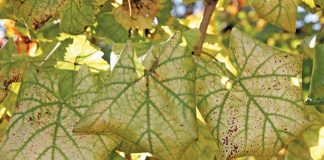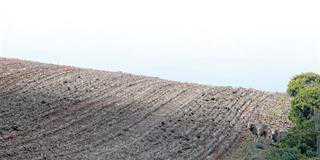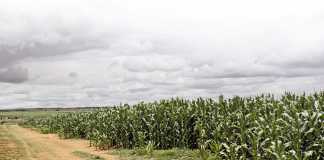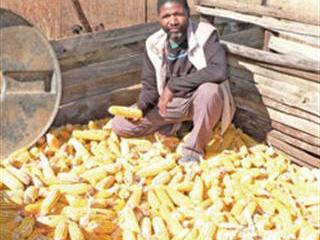
Nicholas Madondo is passionate about three things: his family, his work as evangelist, and following conservation agriculture methods on his homestead at Potshini, on amaNgwane Traditional Authority land near Bergville. For him, the rewards come not only from his personal progress as a farmer, but his efforts to promote conservation agriculture by training other farmers in KZN for the Msizi Consulting non-government organisation.
Born and raised in Potshini, as a youngster Nicholas helped his parents tend their crops and livestock on a small piece of tribal land. From 1990 he had a full-time job in Durban, but in 1997 he finally came home as a full-time father and farmer. “Since then I’ve run cattle and goats on communal grazing land, grown white and yellow maize, and more recently tried sugar beans,” he says. “Until 2002, I only used conventional tillage methods, as my parents and their parents and other communal crop farmers have done for many years.”
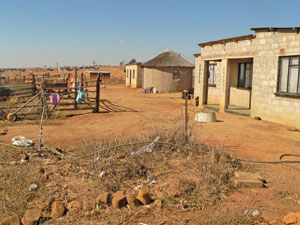
Nicholas’s homestead at Potshini. He gave up his job in Durban to become full-time farmer.
Though commercial farmers in the area have long used conservation tillage methods, Nicholas saw first-hand how he could farm more sustainably, when in 2002 Agricultural Research Council (ARC) representatives visited the Potshini area looking for communal farmers to train in conservation agriculture principles. Intrigued by what he heard, he immediately volunteered. Over five years, the ARC presented monthly leadership and conservation agriculture courses to the Emmaus Landcare Farmers’ Forum, of which Nicholas and other interested communal farmers are members.
It also had a local training site where it hosted practical learning days for Nicholas and his colleagues, and visited the forum’s members individually to give them personalised advice on implementing and maintaining conservation agriculture practices.
“What first appealed to me about minimum tillage and no-till is that they save time, conserve soil and water, and can increase yield,” Nicholas explains.
Better results when ploughing with oxen
To prepare their 1,8 ha land for maize, he and his family have always used ox-drawn implements. Conventional tillage needed three passes for ploughing, disking and planting, and ploughing alone could take a week because of the heavy work for the oxen, which needed regular rest breaks. Then Nicholas started using minimum tillage methods – shallow ripping to 15cm depth. Now he needed only one pass followed by a hand-hoe to dig and cover holes for planting the seed.
When he started using no-till methods, he only needed the oxen to make one pass for planting. This only took a day, saving time and reducing strain on the animals. “With an ox-drawn no-till planter, the time saved allows me to focus on other work,” Nicholas explains. “Planting all the seed in one day also makes the maize germinate evenly.”
Minimum tillage and no-till also improve soil condition. With traditional tillage, Nicholas found that crops planted into land where heavy rain had washed away the topsoil remained stunted and yielded poorly. Now he prevents the problem by conserving topsoil and incorporating as much organic matter into the soil as possible.
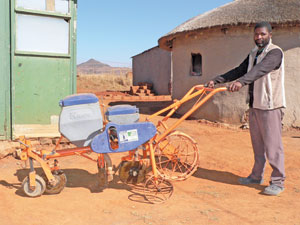
Nicholas shares the R17 100 planter with around 29 other local no-till maize farmers.
Crop residue on the soil surface reduces weed growth. Organic material in the soil improves the soil structure and encourages soil microbes and earthworms. Earthworms are especially good because they eat the decomposing crop residue and carry the nutrients down to the crop root zone. With traditional tillage Nicholas never saw earthworms in the soil, but now he sees them regularly on the soil surface, especially when it rains. Their tunnels help rainwater penetrate deeper into the soil.
Soon after he started leaving crop residue on the soil surface in winter, Nicholas noticed an improvement in the performance of summer crops. “Crop residue and organic matter in the soil conserve moisture,” he stresses. “This is important as rain is unreliable here. This also improves soil moisture penetration, reduces erosion and prevents surface soil compaction from heavy rain.
Livestock graze only a portion of the maize and sugar bean residue before they’re removed from the land. To reduce soil compaction, he never lets them onto the residue if the soil is wet. In winter he lets weeds grow in the land as soil cover, only spraying herbicide before planting the next crop.
Experts emphasise correcting soil acidity levels before converting to no-till, and Nicholas applied 13t/ha dolomitic lime to his land in a liming programme run in his area, funded by the KZN Department of Agriculture and Environmental Affairs. He plans to continue liming his soil every second summer according to Cedara recommendations.
The pay-off
Since adopting conservation tillage, Nicholas has seen a gradual yearly improvement in yield, and maize diseases are virtually non-existent. He also plants only non-GM maize and sugar bean seed and uses seed developed over many years by farmers in the area, which he believes has helped boost his yields. This seed might have evolved good tolerance to local diseases, he says.
In a good year, Nicholas harvests 4t/ha to 5t/ha of maize grain. He keeps some of the white maize grain for his family’s use and sells the rest, along with all yellow maize grain, in 50kg bags to community members. He sells sugar beans via an agent in Ladysmith. He doesn’t keep records of his bean yields, but recalls harvesting 750kg on 0,4ha leased from a neighbour in 2009.
Pest control
Crop pests, mainly maize stalk borer and cutworm, are seldom a problem. “I haven’t seen any change in pest levels between conventional and conservation tillage. But the pesticides I use are very effective,” he says. Every summer, Nicholas follows a specific crop management programme. If there’s been heavy weed growth in fallow lands during autumn and winter, he sprays glyphosate from a knapsack sprayer six weeks before planting.
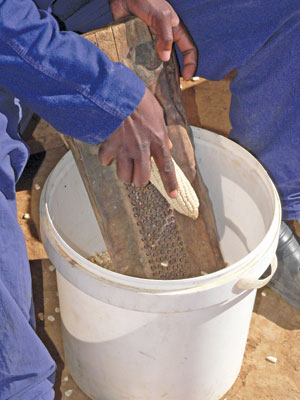
Much of Potshini’s maize is shucked the traditional way: by hand.
If the weeds are below 5cm tall, the dose is 300ml glyphosate in 16l water; if they’re taller, it’s 500ml glyphosate in 16l water. The total application rate is around 160l/ha glyphosate-water mix. A second glyphosate spray two days post-planting, but including 100ml Dual Gold, takes care of nut grass. He also applies a pesticide, such as 50ml Karate Z, at the same time.
Nicholas applies fertiliser (200kg/ha DAP, as recommended by Cedara based on soil analysis) through the no-till planter at planting. Both maize and sugar bean seed is typically planted at 25kg/ha. A week after germination he sprays 20l/ha to 40l/ha of one tablet Decitab dissolved in 16l water, to control cutworm and other insect pests while the plants are still young and sensitive.
Thereafter, based on keen observation, he applies another Decitab spray. Six weeks after planting he again sprays Decitab, followed immediately by a hand-applied top-dressing of 250kg/ha LAN fertiliser. Just before the maize starts flowering, he sprays a mix of 100 ml of Basagran per 16l of water to control burr weed, and applies granular stalkborer killer by hand to the growth tip of each maize plant.
From then until harvesting Nicholas keeps a close eye on the crop, spraying Decitab or Karate Z at a rate of 20ml in 16l water on any plant and its immediate neighbours affected by stalk borer. He only applies a fungicide to sugar beans on the advice of the Bergville agricultural extension officer.
Looking past the farm gate
Nicholas knows there’s little unused arable land at Potshini, but still prays for access to 50ha or more to manage under no-till to produce food and income for his church and congregation. “I’d also use it as a no-till training facility for my congregation and other interested people from around the country,” he says.
“But until then I’ll keep training small groups of people on my land.” He’d also like to see communal farmers everywhere converting to no-till and sustainable farming to improve yields. “Too many communal farmers have given up after watching their yields drop year by year under conventional tillage. Climate change is the main cause of this fall, and no-till is the only way to minimise its negative effects.”
Nicholas’s vision for no-till farming in communal areas
“I’d like to see every community establish its own no-till farming forum, so that community members can share ideas among themselves and with other forums. The forums can also encourage people to change to no-till, or start farming again using no-till, and support them during the change.
“I’d also like to see more outside stakeholders such as government departments, politicians, the Agricultural Research Council, non-governmental rural development organisations and even private companies involved in developing and supporting no-till in communal areas. We must invite political leaders and policy-makers to these forums so that they can understand what people really need to become self-sufficient and sustainable food producers with the resources they have.”
Contact Nicholas Madondo on 082 253 1274 or email [email protected].











